Innovative Designs in Corner Store Counters for Enhanced Retail Efficiency in 2025
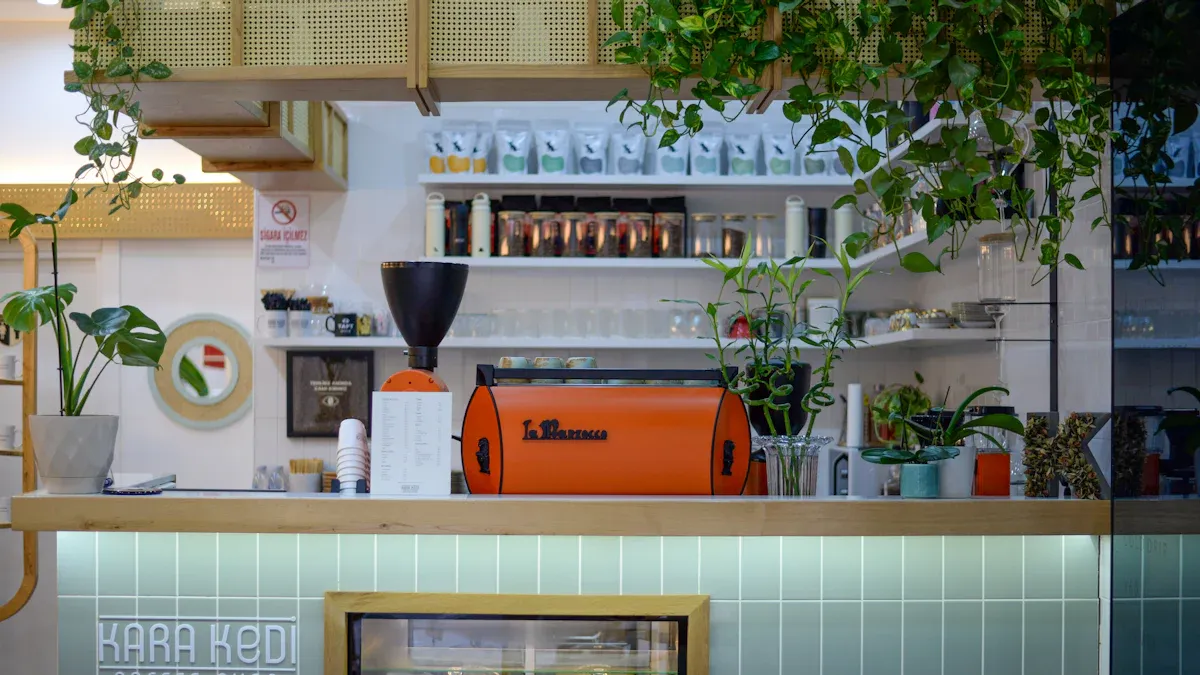
Retail continues to evolve at a remarkable pace, demanding innovative counter designs that drive both efficiency and customer-centric strategies. In 2024, employee turnover rates dropped as productivity rose, while in-store transactions increased, reflecting a shift in customer behavior. The global convenience store market, valued at USD 2 trillion in 2023, projects steady growth through 2032. Innovative counter designs now blend technology, sustainability, and aesthetics to meet these new demands. Retailers invest in innovation to create counters that support operational excellence and deliver an enhanced customer experience. Innovative Designs set the standard for future-focused stores.
Key Takeaways
Innovative retail counters combine technology, sustainability, and style to boost store efficiency and customer satisfaction.
Modular counter designs let stores quickly change layouts, improving space use and increasing sales.
Self-checkout and contactless payments speed up transactions, reduce wait times, and enhance the shopping experience.
Sustainable materials lower costs and support eco-friendly business goals, attracting more customers.
Personalized digital tools and smart layouts help stores engage customers and build loyalty.
Innovative Designs
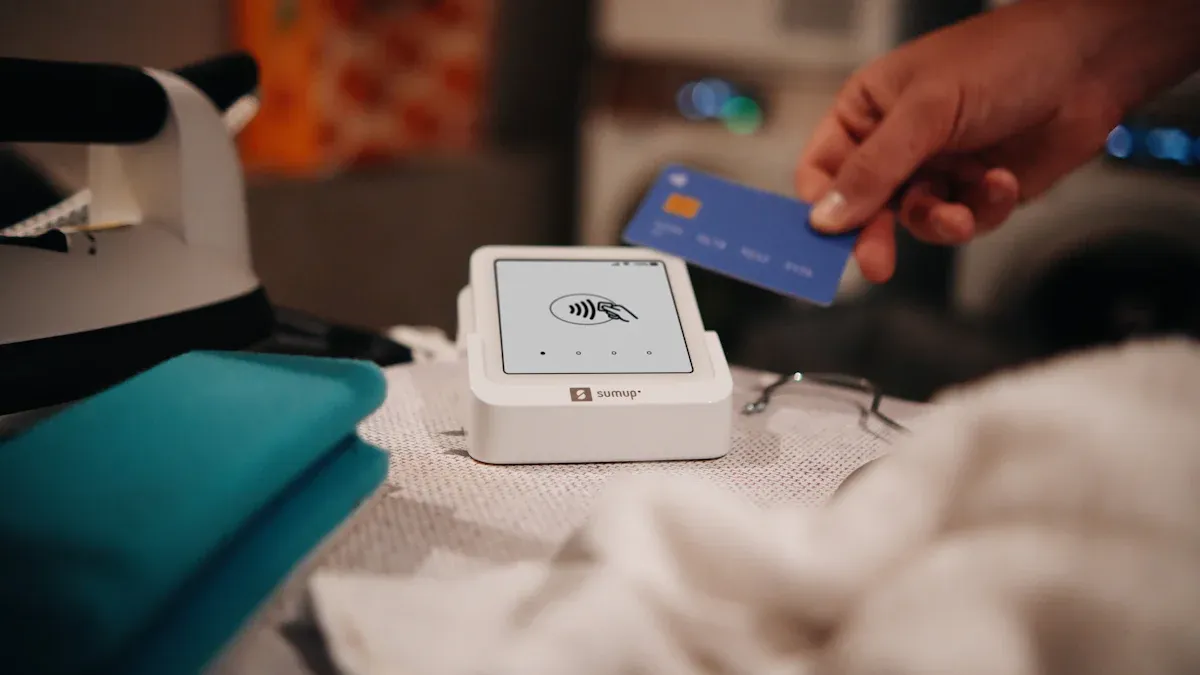
Trends 2025
Retail environments in 2025 showcase a new era of innovative designs that blend technology, sustainability, and visual appeal. Store owners now prioritize counters that do more than process transactions. They seek solutions that improve efficiency, support brand identity, and create memorable customer experiences.
AI-powered counters help staff predict peak hours and adjust workflows, reducing wait times and boosting throughput.
Contactless payment systems and self-checkout stations have become standard, allowing customers to complete purchases quickly and securely.
Eco-friendly materials, such as recycled wood and natural stone, dominate counter surfaces. Over half of design experts identify mixing materials as the leading trend, while 58% say natural stone is the most in-demand countertop material.
Modular counter layouts allow stores to adapt to seasonal promotions and changing product displays, supporting operational flexibility.
Luxury finishes, ample storage, and integrated beverage stations also gain popularity, reflecting a shift toward both function and style.
A major department store redesigned its retail sales counter and saw a 40% increase in customer throughput. This change demonstrates how innovative designs can directly impact operational efficiency.
The countertop market is projected to reach USD 134.7 billion in 2025, with a strong focus on engineered stone, quartz, and sustainable surfaces. Growth drivers include urbanization, remodeling trends, and the demand for durable, attractive counters. Retailers who invest in these trends position themselves to meet evolving consumer expectations and stay ahead in a competitive market.
Technology Integration
Integrated technology now defines the modern retail counter. Retailers use advanced POS systems, digital payment options, and AI-driven analytics to streamline operations and enhance the customer journey. Self-checkout technology, in particular, has proven to improve service speed and reduce queue lengths, leading to higher customer satisfaction and measurable gains in efficiency.
A large-scale survey confirms that self-checkout and digital payment systems positively influence customer satisfaction by speeding up service and minimizing wait times. Discount grocery stores that adopted these strategies reported statistically significant reductions in customer wait times and improved convenience.
Retailers use innovative checkout options and autonomous stores to increase customer efficiency.
Retailer apps and communication tools enhance the customer experience.
In-store robots and smart wearables boost employee productivity and comfort.
Boutique stores now design POS counters as central visual elements, merging aesthetics with practical utility. Electronics retailers use modular counters for seasonal flexibility, while health and beauty stores integrate organic materials to align with brand values. Bookstores and fashion retailers create dual-purpose counters that optimize space and attract target demographics.
Ergonomic and modular counter designs not only improve staff comfort but also adapt to changing retail needs, supporting both efficiency and customer engagement.
Sustainability and green building codes increasingly influence material choices. Digital printing and lightweight composites transform product offerings, making innovative designs more accessible and customizable. Regional growth remains strongest in Asia-Pacific, driven by urbanization and rising incomes.
Retailers who embrace these integrated technology solutions and innovative designs set new standards for efficiency, adaptability, and customer satisfaction in 2025.
Retail Counter Design
Modularity
Retail counter design in 2025 centers on flexibility and adaptability. Store owners now choose flexible counter designs that allow quick changes for seasonal promotions or busy periods. Modular counters can move or reconfigure to fit new layouts, making it easy to adjust for different products or customer flows. This approach supports both small and large stores, giving them the ability to respond to changing needs without major investments.
Measurable Outcome / Metric | Example / Supporting Detail | |
|---|---|---|
Impulse Purchases | Up to 80% increase | Direct sales improvement linked to modular counters |
Wait Time Reduction | Reduced customer queue times | Mobile checkout solutions enable flexible service |
Space Optimization | Improved space utilization | Modular adjustable components allow setup changes |
Sales Growth | 25% sales increase | IKEA reported sales growth through layout optimization within 3 months |
Customer Engagement | Up to 60% increase in product interaction | Heat map and customer flow analysis data |
Cart Value Increase | 10-20% increase | Cross-selling optimization with product placement |
Traffic Increase | Up to 30% increase in store traffic | Customer movement tracking and layout modifications |
Operating Cost Reduction | 20% reduction | Sustainable counter designs and eco-friendly materials |
Environmental Benefits | 77% waste reduction | Forecast optimization and reusable bag implementation |
Business Flexibility | Adjustable components for seasonal/peak changes | Quick reconfiguration without extra investment |
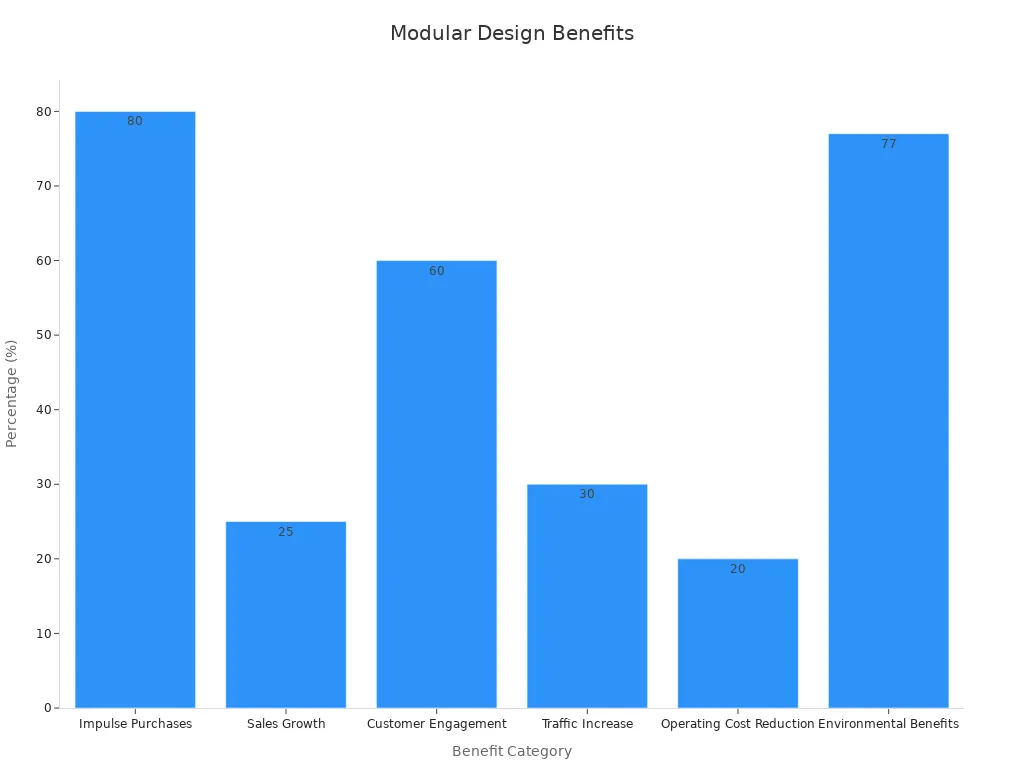
Flexible counter designs help stores optimize space and improve customer engagement. For example, IKEA saw a 25% sales increase after optimizing layouts with modular counters. Stores also report up to 80% more impulse purchases and a 20% drop in operating costs. These results show the value of modularity in retail counter design.
Sustainability
Sustainability shapes every aspect of modern retail counter design. Store owners now select eco-friendly designs that use recycled wood, natural stone, and lightweight composites. These materials support sustainable store concepts and reduce environmental impact. Retailers also see a 77% reduction in waste by using reusable bags and forecast optimization.
AI and IoT tools help retailers place counters and products for maximum efficiency. For example:
Queue management systems with digital signage reduce wait times and improve satisfaction.
Linear queue systems display real-time updates, streamlining checkout and boosting sales.
Data analytics and heat maps track customer movement, helping stores redesign layouts for better flow and higher sales.
Strategic product placement increases exposure and can boost sales by up to 30%.
AI-driven simulations test different layouts, improving customer flow and engagement.
Clear aisles and easy navigation improve staff productivity and create a better shopping experience.
Retailers who invest in sustainable and flexible counter designs lead the way in efficiency and customer satisfaction. These strategies support both business growth and environmental responsibility.
Experience
Customer Flow
Retailers in 2025 focus on optimizing the retail shopping experience by improving customer flow. Store owners use data from traffic counters to identify high-traffic areas and place high-demand products where customers see them first. This strategy increases visibility and drives sales. Staff schedules now match anticipated foot traffic, ensuring efficient service during busy times. Retailers design checkout areas to reduce wait times, which prevents customer drop-offs and creates a seamless shopping experience.
The following table highlights how leading retailers benefit from optimized counter placements:
Retailer | Metric/Improvement | Value/Result |
|---|---|---|
Hurley | Conversion Rate Increase | 5% increase |
Camper | Labor Cost Savings | 30% year-on-year savings |
Camper | Customer Satisfaction Increase | 10% year-on-year increase |
Camper | Marketing Spend Efficiency | 30% year-on-year savings |
Sharaf DG | Customer Visits | Over 1 million monthly visits |
The Vitamin Shoppe | Labor Forecasting & Payroll Efficiency | Improved profitability |
Retailers also apply these practices:
Place products based on customer movement patterns to enhance accessibility.
Train staff to engage customers at key touchpoints.
Use real-time data to adjust layouts for unique shopping experiences.
These strategies support customer experience enhancement and help stores deliver personalized customer experiences.
Digital Displays
Digital displays transform the retail environment by enhancing customer engagement and communication. Interactive screens guide customers through the store, offer personalized promotions, and provide product information. Shoppers spend three times longer engaging with interactive displays than with traditional signage. Up to 83% of shoppers find these displays effective in making purchase decisions, which leads to a significant sales boost.
Metric Description | Numerical Data |
|---|---|
Shoppers finding interactive displays effective in purchase decisions | 83% |
Sales increase attributed to interactive displays | Up to 75% |
Increase in sales due to proper lighting | Up to 40% |
Increase in brand recognition due to color | Up to 80% |
Customer attention duration with interactive displays vs traditional | 3 times longer |
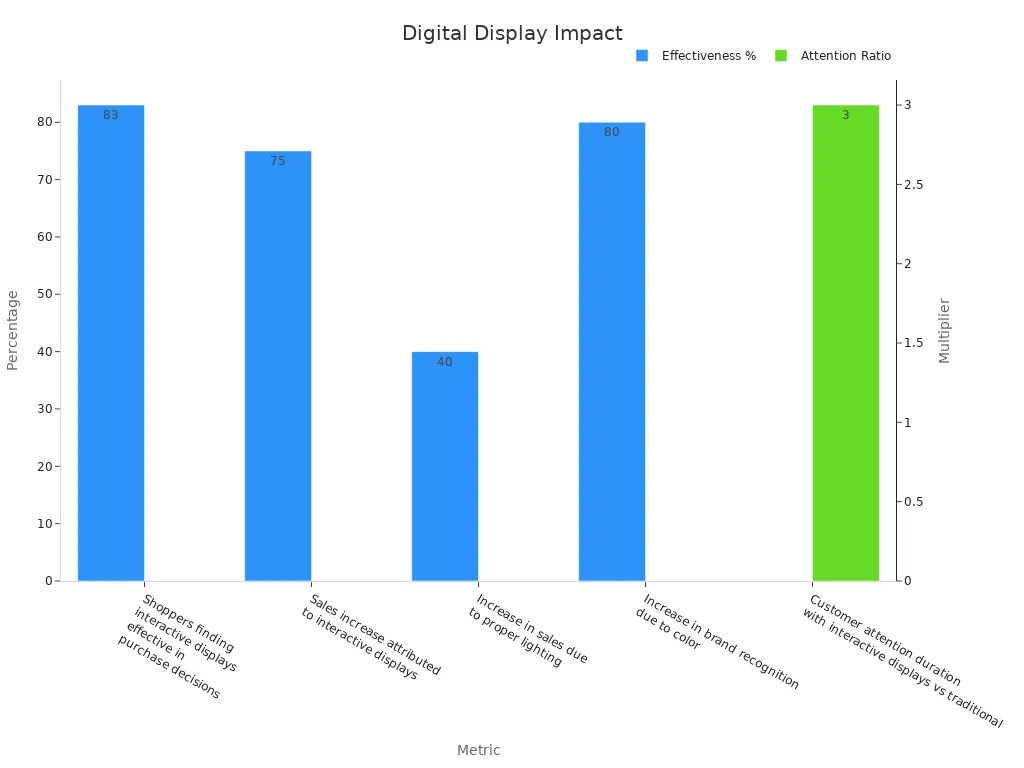
Retailers use digital displays to create immersive store experiences and deliver personalized content. These tools help stores stand out and provide unique shopping experiences. Proper lighting and color choices further enhance the checkout experience and brand recognition. By focusing on enhancing customer experience, retailers ensure every visit feels personalized and memorable.
Efficiency
Faster Transactions
Retailers in 2025 focus on efficiency at every stage of the checkout process. Modern counter designs use technology and ergonomic features to speed up transactions and improve the overall checkout experience. Store owners choose adjustable height countertops and provide ample storage to help staff work quickly and comfortably. Touchscreen displays and contactless payment systems allow customers to pay faster and reduce waiting times.
Adjustable counters help staff reach items easily and keep the area organized.
Touchscreen displays guide both staff and customers through the payment process.
Contactless payment systems let customers pay with a tap, making lines move faster.
Organized storage keeps supplies close, so staff do not waste time searching.
These features work together to boost efficiency and create a smooth retail environment. Customers enjoy shorter lines and faster service, while staff can focus on delivering great service.
Tip: Retailers who invest in ergonomic and tech-driven counters often see a direct improvement in transaction speed and customer satisfaction.
Staff Productivity
Innovative counter designs do more than speed up transactions. They also help staff work better and feel more comfortable. Studies show that well-designed retail spaces improve employee health, reduce absenteeism, and increase productivity. The table below highlights key improvements seen after implementing modern counter and workspace designs:
Productivity Measure | Improvement / Outcome |
|---|---|
Absenteeism | 19% improvement (employees working more than expected increased) |
Presenteeism | 16% increase (employees working at 90% of possible job performance vs. previous office) |
Physical Health Scores | 2% improvement within one year of occupancy |
Financial ROI | Investment recouped within first half of 10-year lease due to productivity gains and retention |
Employee Retention | Improved due to perceived environmental quality affecting turnover intention (Cornell study cited) |
Environmental Quality | Improved indoor air quality, lighting, acoustics, and spatial quality contributing to productivity |
Collaboration & Social Support | 42% increase in communication, 44% increase in idea sharing, fostering a collaborative environment |
Retailers who design counters with staff needs in mind see better teamwork and higher job satisfaction. Improved lighting, air quality, and space make it easier for employees to stay focused and motivated. These changes help boost efficiency and support long-term business growth.
Checkout Counter Design
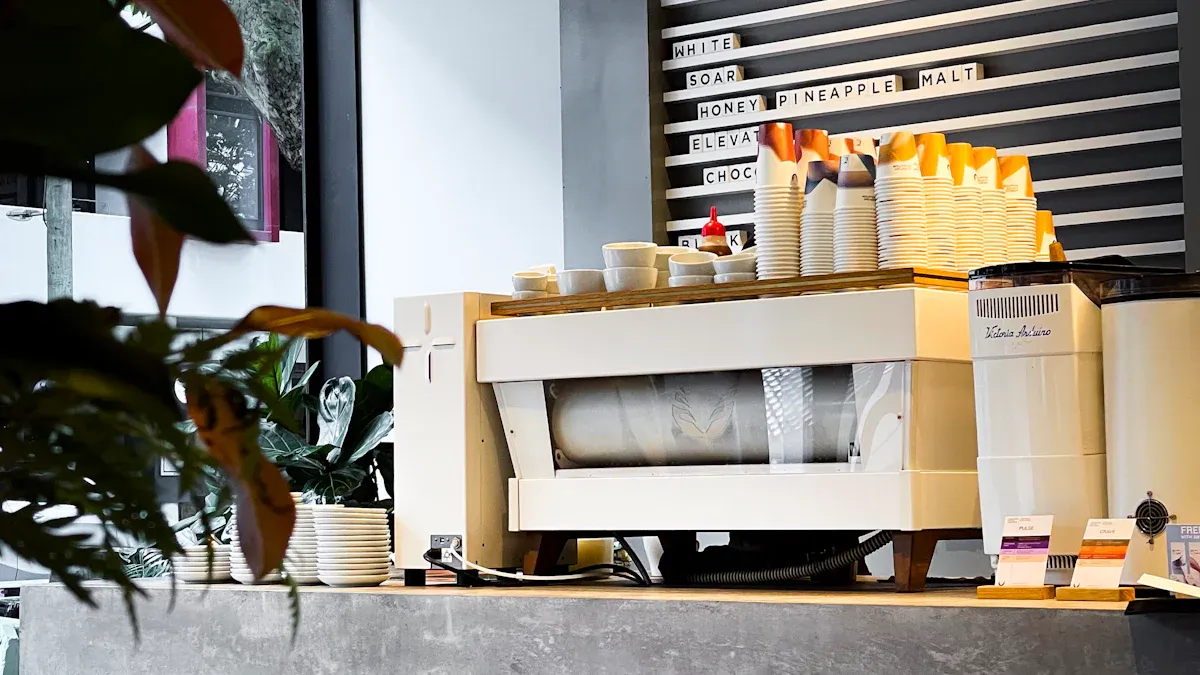
Self-Checkout
Retailers in 2025 rely on advanced checkout counter design to deliver fast, seamless transactions. Self-checkout stands out as a leading solution for modern retail environments. Many stores now use self-checkout technology to reduce wait times and improve customer satisfaction. Retail checkout counter ideas often include ergonomic layouts, clear signage, and digital screens to guide shoppers through the process.
Self-checkout systems offer measurable improvements for both customers and staff. The following table highlights key benefits:
Measurable Improvement | Description | Percentage/Value |
|---|---|---|
Transaction Speed Increase | Average speed increase in transactions due to self-checkout systems | 30% |
Shopper Preference for Speed | Percentage of shoppers who prefer self-checkout for faster transactions | 77% |
Shopper Preference for Faster Processes to Avoid Lines | Percentage valuing faster checkout to avoid waiting | 66% |
Retailers Reporting Positive Operational Outcomes | Retailers noting benefits from efficiency gains with self-checkout | 91% |
Gen Z Preference for Self-Checkout | Percentage of Gen Z shoppers favoring self-checkout | 63% |
Millennial Preference for Self-Checkout | Percentage of Millennials favoring self-checkout | 45% |
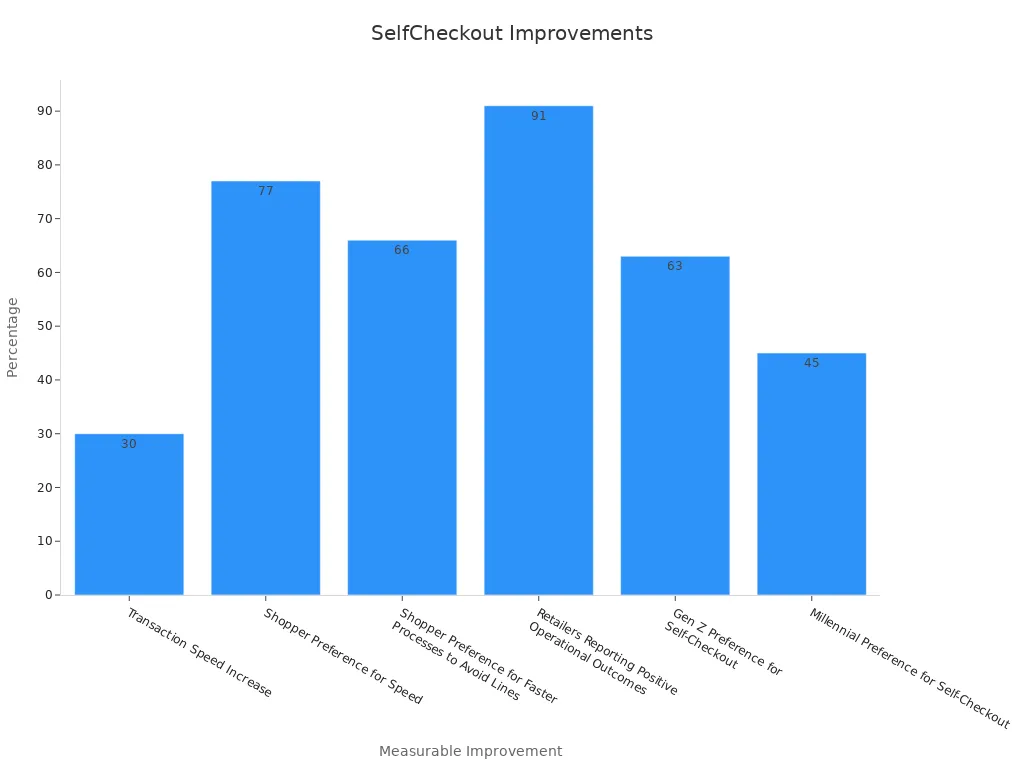
Retail checkout counter ideas now focus on flexibility and speed. Stores use mobile POS systems and compact checkout stand designs to process transactions anywhere on the floor. Self-checkout kiosks appeal to tech-savvy shoppers and those with fewer items. Clear information screens and organized layouts help customers complete purchases quickly. Retailers report that self-checkout technology increases transaction speed by 30% and boosts customer satisfaction. Gen Z and Millennials show strong preferences for these systems, making them essential in modern checkout counter design.
Contactless Payment
Contactless payment has become a core feature in checkout counter design. Retailers worldwide adopt this method to meet customer demand for speed and convenience. Modern checkout stand designs include payment terminals that support tap-to-pay cards and mobile wallets. Retail checkout counter ideas now prioritize security, efficiency, and a frictionless experience.
The table below shows the global rise of contactless payments and their benefits:
Region/Country | Statistic Description | Data/Value |
|---|---|---|
United States | Increase in contactless payments in 2020 compared to 2019 | |
United States | Increase in contactless payments between 2019 and 2021 | 150% increase |
Euro Area | Contactless payments share in 2019 | 41% |
Euro Area | Contactless payments share in 2022 | 62% |
Canada | Percentage of Canadians using contactless payments in 2022 | 85% |
India | Growth in contactless card transactions in FY 2022-23 | 187% increase |
China | Mobile payments as percentage of non-cash transactions in 2022 | 86.4% |
United Kingdom | Contactless payments as percentage of all card transactions in 2022 | 57% |
United States | Percentage of in-person transactions at contactless-enabled merchant locations (2023) | Over 80% |
Retail checkout counter ideas that include contactless payment options lead to faster checkout times and higher customer satisfaction. These systems also improve security and reduce cash handling risks. Retailers benefit from lower transaction costs and increased sales, especially from impulse purchases. Checkout counter design now centers on digital and mobile payment trends, ensuring stores stay competitive in the evolving retail landscape.
Tip: Retailers who invest in modern checkout stand designs with self-checkout and contactless payment features see measurable gains in efficiency and customer loyalty.
Implementation
Customization
Retailers in 2025 demand solutions that fit their unique needs. Custom retail counters allow stores to tailor layouts, technology, and materials for their brand and customer base. These counters support interactive displays, digital signage, and proximity tracking systems. Retailers use these features to deliver targeted promotions and personalized experiences. For example, proximity tracking can trigger special offers when a customer approaches a display, increasing engagement and sales.
Personalized experiences grow as retailers track preferences and purchase history.
Real-time analytics help optimize inventory and reduce stockouts.
Interactive displays provide product information and customization options.
Data-driven merchandising improves product placement and assortment.
Targeted marketing campaigns boost engagement and loyalty.
A three-month study in a mid-sized electronics store showed a 30% increase in customer interactions with promotional displays and a 15% higher redemption rate for personalized offers. Sales for products linked to proximity-triggered promotions rose by 10%, while conversion rates improved by 5%. Operational efficiency also increased, with a 20% reduction in out-of-stock items and better staff allocation during peak times.
Retailer | Innovation Description | Performance Metrics |
|---|---|---|
Sephora | Interactive play zones with digital try-ons and solution-based merchandising | 35% increase in average transaction value; 45% increase in repeat visits |
Target | Store redesign with dual-entrance, curved layouts, and enhanced product storytelling | 2-4% sales growth in redesigned stores |
Warby Parker | Gallery-like displays, integrated exam services, seamless digital-physical experience | Sales per square foot exceeding $3,000 |
Scalability
Scalable design solutions help retail stores grow and adapt quickly. Cloud-based platforms and modular systems allow retailers to expand from one location to many without major changes. Headless Digital Asset Management and eCommerce APIs let stores manage media and product displays across multiple channels. This flexibility supports faster deployment of new features and personalized shopping experiences.
Autonomous store networks cut labor costs by up to 30% through automation.
Real-time tracking and robotic monitoring reduce out-of-stock items by 20–30%.
Dynamic pricing adjusts in real time to maximize revenue.
Cloud platforms like Microsoft Azure and AWS support expansion from single stores to large networks.
Amazon Go and Żabka Nano grew rapidly by using scalable design, proving the model works.
Retailers who invest in scalable solutions stay competitive and meet changing consumer demands. These strategies ensure consistent customer experiences and support long-term growth.
Adopting innovative counter designs brings measurable benefits to corner stores in 2025.
Sleek counters streamline space and speed up transactions, improving operational flow.
Integrated technology, such as self-checkout, reduces wait times and enhances the customer experience.
Sustainable materials boost brand reputation and lower costs.
Modular layouts increase adaptability for any retail environment.
Personalized digital tools create a memorable experience and foster loyalty.
Store owners should review current setups, explore new solutions, and consult experts to stay ahead in the evolving retail landscape.
FAQ
What are the main benefits of modular retail counters?
Modular counters let stores change layouts quickly. They help with seasonal displays and special promotions. Store owners can move or add sections as needed. This flexibility supports better customer flow and higher sales.
How does technology improve retail counter efficiency?
Technology like self-checkout, contactless payments, and AI-driven analytics speeds up transactions. These tools help staff serve customers faster and reduce errors. Stores see shorter lines and happier shoppers.
Why should stores use sustainable materials for counters?
Sustainable materials lower environmental impact and support green business goals. They also attract eco-conscious shoppers. Many retailers report cost savings from using recycled or natural materials.
Can small stores afford innovative counter designs?
Store Size | Affordable Solutions |
|---|---|
Small | Modular units, digital POS |
Medium | Self-checkout, eco materials |
Large | Full tech integration |
Small stores can start with modular counters or digital payment systems. These options fit most budgets and offer quick returns.
See Also
Space-Efficient Snack Vending Machines Designed For Small Areas
Understanding The Growth Of AI-Driven Corner Store Retail
Discovering The Elegant Appeal Of Modern Corner Stores
How Time Out Corner Stores Transform Urban Convenience Today
